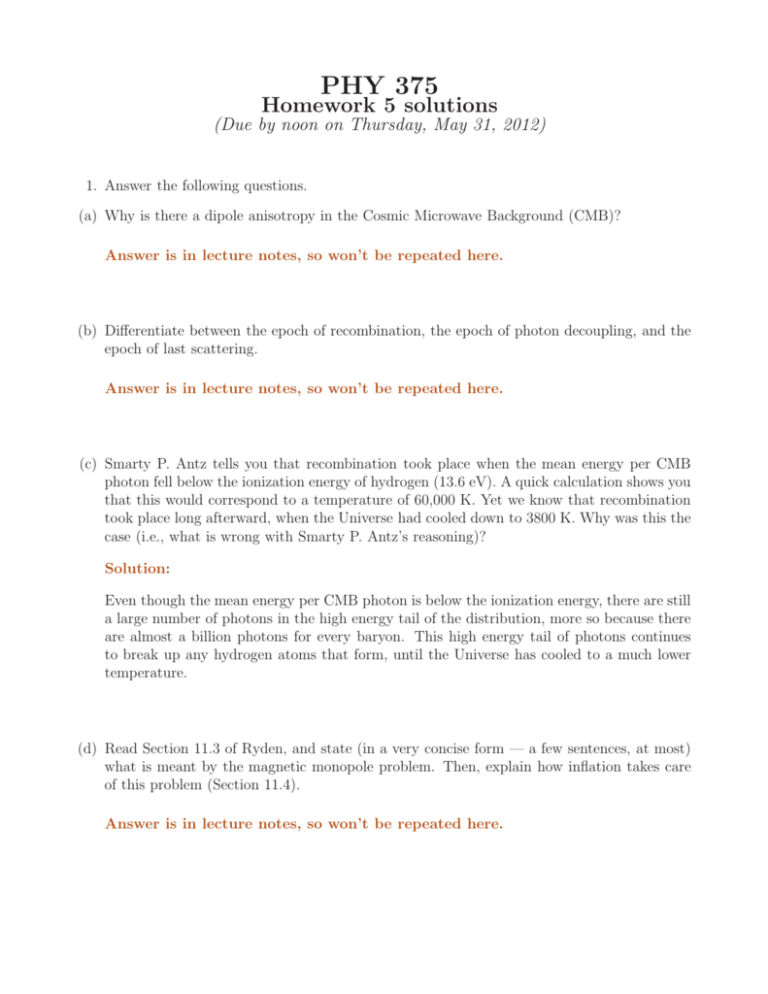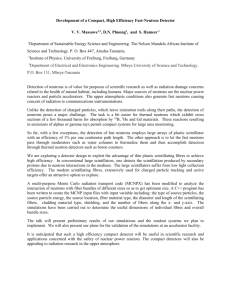HW 5 solutions - DePaul University
advertisement

PHY 375 Homework 5 solutions (Due by noon on Thursday, May 31, 2012) 1. Answer the following questions. (a) Why is there a dipole anisotropy in the Cosmic Microwave Background (CMB)? Answer is in lecture notes, so won’t be repeated here. (b) Differentiate between the epoch of recombination, the epoch of photon decoupling, and the epoch of last scattering. Answer is in lecture notes, so won’t be repeated here. (c) Smarty P. Antz tells you that recombination took place when the mean energy per CMB photon fell below the ionization energy of hydrogen (13.6 eV). A quick calculation shows you that this would correspond to a temperature of 60,000 K. Yet we know that recombination took place long afterward, when the Universe had cooled down to 3800 K. Why was this the case (i.e., what is wrong with Smarty P. Antz’s reasoning)? Solution: Even though the mean energy per CMB photon is below the ionization energy, there are still a large number of photons in the high energy tail of the distribution, more so because there are almost a billion photons for every baryon. This high energy tail of photons continues to break up any hydrogen atoms that form, until the Universe has cooled to a much lower temperature. (d) Read Section 11.3 of Ryden, and state (in a very concise form — a few sentences, at most) what is meant by the magnetic monopole problem. Then, explain how inflation takes care of this problem (Section 11.4). Answer is in lecture notes, so won’t be repeated here. PHY 375 (Spring 2012) Homework 5 solutions 2. When the Universe was fully ionized, photons interacted primarily with electrons via Thomson scattering, for which the cross-section is σe = 6.65 × 10−29 m2 . (a) Find the average distance traveled by a photon between collisions, also known as the mean free path: λmfp = 1/ne σe , at the time of radiation-matter equality when arm ≈ 3 × 10−4 . Solution: When fully ionized, ne ≈ nbary . But nbary ∝ 1/a3 , so we get nbary = nbary /a3 , assuming a0 = 1. Therefore, with a = arm at the time of radiation-matter equality, we get λmfp = 1 = nbary /a3rm σe a3rm (3 × 10−4 )3 = = 1.8 × 1018 m nbary σe (0.22 m−3 )(6.65 × 10−29 m2 ) (b) The Friedmann equation for a radiation-dominated flat universe is H2 Ωr,0 = 4 2 H0 a Use this to find the Hubble parameter at the time of radiation-matter equality when arm ≈ 3 × 10−4 . Take the value of Ωr,0 from the Benchmark model. Solution: Hrm = H0 p Ωr,0 a2rm √ (70 km s−1 Mpc−1 ) 8.4 × 10−5 = = 71 × 105 km s−1 Mpc−1 (3 × 10−4 )2 (c) The photons remain coupled to the electrons as long as their mean free path λmfp is shorter than the Hubble distance c/H. Verify that they are coupled at the time of radiation-matter equality. Solution: Converting Hrm to SI units, we find c/Hrm = 1.3 × 1021 m. Therefore, clearly λrm = 1.8 × 10 18 m < c 21 = 1.3 × 10 m Hrm and so the photons are coupled to the electrons at the time of radiation-matter equality. Page 2 of 8 PHY 375 (Spring 2012) Homework 5 solutions 3. Given that the Universe is described by the Benchmark model, and the redshift of the last scattering surface is zls = 1100, (a) Find the angular diameter distance to the surface of last scattering. Solution: From equation (6.42) in Lecture 11, we know that the horizon distance in the Benchmark model is given by c dhor (t0 ) = 3.24 = 14, 000 Mpc H0 And, from equation (7.41), we know that as z → ∞, the angular distance dA ≃ dhor (t0 ) z Therefore, the angular distance to the surface of last scattering will be dA ≃ 14, 000 Mpc dhor (t0 ) = = 13 Mpc zls 1100 (b) Find the luminosity distance to the surface of last scattering. Solution: From equation (7.37) in Lecture 12, we get 2 2 dL = dA 1 + z = 13 Mpc 1 + 1100 = 1.6 × 107 Mpc (c) Find the proper distance dp (t0 ) to the surface of last scattering. Solution: From equation (3.28) in Lecture 5, we get dp (t0 ) = r Meanwhile from equation (7.36) in Lecture 12, we get dA = r Sκ (r) = 1+z 1+z because Sκ (r) = r in a flat universe, which is the case here since we’re assuming the Benchmark model. Combining the two equations above, we get dp (t0 ) = dA 1 + z = 13 Mpc 1 + 1100 ≈ 14,000 Mpc Page 3 of 8 PHY 375 (Spring 2012) Homework 5 solutions 4. Big Bang Nucleosynthesis of 4 He was a race against time to bind neutrons before they decayed to protons. (a) First, prove that the maximum possible value of the primordial 4 He fraction is h i Yp max = 2f 1+f where f = nn /np ≤ 1 is the neutron-proton ratio at the time of nucleosynthesis. Solution: First, since f = nn /np , we get nn = f np . Now, we get the maximum 4 He fraction if all available nn neutrons bind to protons. Since there are 2 neutrons (and 2 protons) in one 4 He nucleus, this implies that we would get nn /2 nuclei of 4 He. Furthermore, since one 4 He nucleus has a mass of 4mp , where mp is the mass of a proton, nn /2 such nuclei will have a mass of (nn /2) 4mp . We are assuming mp = mn . And, since we have a total of (nn + np ) neutrons and protons, their mass will be (nn + np ) mp . From the above considerations, we get h i Yp max = (nn /2) 4mp 2nn 2(f np ) = = (nn + np )mp nn + np f np + np Therefore, canceling common terms and rearranging, we get h i Yp max = 2f 1+f (b) Assuming that the neutron-proton ratio remained constant at f = nn /np = 1/5 after freezeout, and that all available neutrons were incorporated into 4 He, find the value of [Yp ]max . Solution: For f = 1/5, we get h i Yp max = 2f 2(1/5) 2/5 2 1 = = = = 1+f 1 + 1/5 6/5 6 3 Therefore, we get h i Yp max = 0.33 Page 4 of 8 PHY 375 (Spring 2012) Homework 5 solutions (c) In reality, [Yp ]max was less than this value because some of the free neutrons decayed into protons, thereby decreasing the number of neutrons available to combine with protons to form 4 He. Show that if nucleosynthesis starts after a time delay of tnuc , neutron decay makes the neutron-to-proton ratio decrease from its freeze-out value of nn /np = 1/5 to exp (−tnuc /τn ) nnf h i = npf 5 + 1 − exp (−tnuc /τn ) where τn is the decay time of the neutron. Solution: At freeze-out, we have nni /npi = 1/5, so npi = 5nni . Given that if you start out with a population of free neutrons nni , the number of free neutrons remaining after time tnuc will be tnuc nnf = nni exp − τn The remaining neutrons become protons, so the number of protons after time tnuc is h i npf = npi + nni − nnf Putting npi = 5nni and the expression for nnf into this expression, we get h i npf = 5nni + nni − nni exp(−tnuc /τn ) and this may be written as n h io npf = nni 5 + 1 − exp(−tnuc /τn ) From the expressions above, we obtain nnf n exp(−tnuc /τn ) n nih io = npf nni 5 + 1 − exp(−tnuc /τn ) Therefore, we get the desired expression: exp (−tnuc /τn ) nnf h i = npf 5 + 1 − exp (−tnuc /τn ) Page 5 of 8 PHY 375 (Spring 2012) Homework 5 solutions (d) As a result of the process described in part (c), find the neutron-proton ratio fnew = nnf /npf , and the corresponding value of [Yp ]max , if nucleosynthesis starts after a delay of tnuc = 200 s, and the decay time of the neutron is τn = 890 s. Assume that all available neutrons (that haven’t decayed) are incorporated into 4 He nuclei. Solution: Given tnuc = 200 s, and τn = 890s, we get fnew = nnf exp (−200/890) h i = 0.15 = npf 5 + 1 − exp (−200/890) and h i New Yp max = 2(0.15) 2fnew = = 0.26 1 + fnew 1 + 0.15 (e) Suppose, instead, that the neutron decay time were τn = 89 s, with all other physical parameters unchanged (including that we still have tnuc = 200 s). Calculate [Yp ]max , again assuming that all available neutrons are incorporated into 4 He nuclei. Solution: With tnuc = 200 s, and a smaller τn = 89s, we get fnew = nnf exp (−200/89) h i = 0.018 = npf 5 + 1 − exp (−200/89) and h i New Yp max = 2(0.018) 2fnew = = 0.04 1 + fnew 1 + 0.018 This makes sense — the neutrons decay faster, so there are fewer neutrons left to form 4 He, so the maximum 4 He fraction is smaller. Continued on the next page . . . Page 6 of 8 PHY 375 (Spring 2012) Homework 5 solutions 5. Consider the inflaton field V (φ) = Aφ4 Equation (11.53) can be used to find when the slow roll condition breaks down by setting EP dV V dφ 2 ∼1 where EP = (~c5 /G)1/2 is the Planck energy. (a) Use the limiting condition given above to find the value of φ at which the slow roll conditions break down; this marks the end of the period of inflation. Leave your answer as an expression, don’t substitute numerical values. Solution: Setting dV = 4Aφ3 dφ in the expression EP2 V2 dV dφ 2 ∼1 we get 2 ~c5 /G 3 4Aφ ∼1 (Aφ4 )2 which works out to ~c5 (16)φ6 ∼1 Gφ8 or 16~c5 φ8 ∼ 6 G φ Therefore, we get φ∼ 16~c5 G 1/2 We can either leave it in this form, or simplify by inserting EP = (~c5 /G)1/2 to get φ∼ 16~c5 G 1/2 Page 7 of 8 ∼ 4EP PHY 375 (Spring 2012) Homework 5 solutions (b) Find the number of e-foldings N. Solution: Equation (11.48): 3H φ̇ = −~c3 dV dφ with dV /dφ = 4Aφ3 gives − 3H dφ = dt ~c3 (4Aφ3 ) Then, we get Z tf a(tf ) N = ln = H(t) dt a(ti ) ti = Z φf Z φf Z φf φi = φi = φi 3H dφ H − 3 ~c (4Aφ3 ) −3H 2 dφ 4A~c3 φ3 −3 4A~c3 φ3 8πGV 3c2 dφ where we have put H = (8πGV /3c2)1/2 . Putting V = Aφ4 , and canceling terms we get 2πG N =− 5 ~c Z φf φi Therefore N =− φ 2πG φ2 f φ dφ = − 5 ~c 2 φi i πG h 2 2 φ − φ i ~c5 f We can leave it in this form, or use the fact that inflation ends of φf = 4EP , together with EP2 = ~c5 /G and write this as 2 i π h 2 φi 2 N = 2 φi − φf = π − 16 EP EP2 Page 8 of 8







